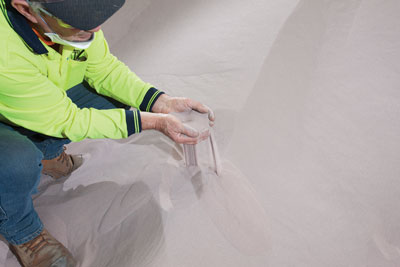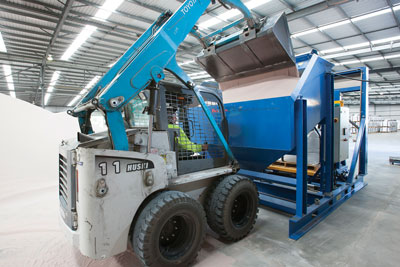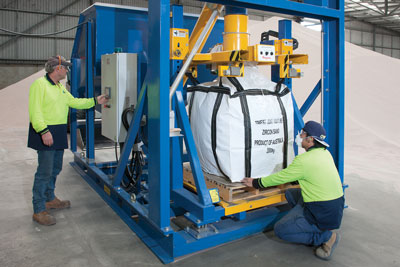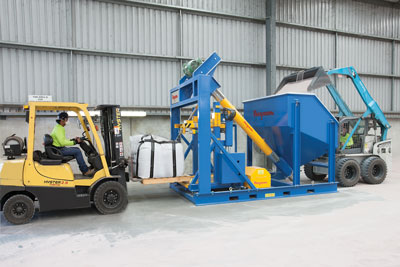 |
 |
 |
 |
| Processed granular zircon and rutile (top photo) are brought to Tronox Western Australia’s shipping facility in dump trucks, where it was previously loaded manually in bulk bags. A recently installed Flexicon automatic bag filler now uses a loader-fed hopper (second photo) to efficiently fill the bags to a pre-set weight (third photo), after which they are moved by forklift to the staging area for shipment. The automatic unit enabled the company to double output per operator in the loading process. |
Tronox Western Australia operates the world’s largest fully integrated titanium ore and titanium dioxide (TiO2) project, covering the spectrum from mining of mineral sands through extraction and upgrading to obtain TiO2 pigment. The project is also a major producer of the mineral zircon (zirconium silicate), also obtained from the mineral sands.
The chief products at Tronox’s Western Australian operations are rutile (TiO2) and zircon (ZrSiO4), which ultimately are loaded into bulk bags at Tronox’s Henderson shipping facility and transported in shipping containers to nearby Fremantle, Western Australia’s largest and busiest cargo port, for export and domestic use.
The loading of bulk bags over the years had become a bottleneck, but has been remedied by a special bulk bag filling station from Flexicon Corp.
Tronox’s Western Australian operations start with the mining of mineral sands, which are gravity-separated at the mine to obtain a wet concentrate that is rich in the desired minerals: rutile (high-grade Ti mineral), ilmenite (FeTiO3, lower-grade Ti mineral), and zircon. The minerals are separated and recovered by magnetic and electrostatic processes at the company’s Chandala dry separation process plant in Muchea. Ilmenite is further refined in a reduction kiln to remove iron and ultimately produce synthetic rutile.
The granular zircon and rutile are brought to the company’s shipping facility in Henderson in dump trucks, which empty their loads onto the concrete floors of large storage sheds. From there, the product is loaded into bulk bags.
The bagging operation was largely a manual process in which a forklift truck held the bag while a second forklift truck held a V-shaped funnel (or hopper) over the bag and a front end loader dropped the ore through the funnel into the bag. When the bag was nearly full it was weighed and the rest of the material was added by hand.
Tronox dramatically improved its bulk bag filling with a heavy-duty, skid-mounted mobile bulk bag filling station that integrates an 88-ft3 (2.5-m3) capacity hopper, a 15-ft long (4.5-m) steel tube screw conveyor, and a Twin-Centerpost bulk bag filler.
Nicknamed “Rhonda” at the Henderson facility, the bulk bag filling station stands 11 ft (3.3 m) at its highest point and is 12 ft (3.6 m) long. It was engineered and supplied by Flexicon Australia, a subsidiary of Flexicon Corp., which is based in Bethlehem, Pennsylvania, USA. The unit doubles output per operator over the former method, while improving health and safety since filling is enclosed and essentially dust-free, according to the company.
Formerly, three employees filled about 80 bags in a 10-hour day. Currently, two employees fill about 90 bags in an 8-hour day using the Flexicon Twin-Centerpost unit to fill bulk bags of differing weights—2,200 lb (1,000 kg), 3,850 lb (1,750 kg) and 4,400 lb (2,000 kg). The unit’s basic design includes two steel posts which support a fill head and pneumatically retractable hooks on which the bag hangs. Enclosing the bulk bag filler and supporting the 15-ft (4.5-m) tubular conveyor is the station’s heavy-duty outer frame.
The bulk bag filling station moves between the zircon- and rutile-filling operations, which are located approximately 875 yd (800 m) apart. Due to its relatively small footprint, the skid-mounted system can be moved using a three-ton forklift.
The hopper can hold 7 to 8 st (6.4 to 7.3 mt) of zircon or 5–6 st of rutile, in granular form. During filling, the front end loader empties material into the hopper while the conveyor draws the material from the inlet at the bottom of the hopper and transports it 15 ft at an incline of 40° before it gravity feeds through the conveyor outlet, transition adapter and telescoping steel downspout into the bulk bag.
The conveyor consists of a steel screw that rotates within an 8.7-in.-dia (220-mm) steel tube. Since both the rutile and zircon are abrasive, the screw is a thick stainless steel spiral designed to heavy-duty mining specifications. The screw automatically self-centers within the tube, allowing a 100% fill percentage. The throughput capacity of the conveyor is 706 ft3/h (20 m3/h), and can fill a 2-st (1.8-mt) bag with zircon in approximately 1-½ minutes.
Powering the screw is a 20-hp (15-kW) variable speed electric motor. The top-driven design of the conveyor allows the abrasive material to exit the conveyor without contacting and wearing bearings or seals.
At the start of a filling operation the operator secures the bag’s four corner loops to the pneumatically retractable hooks. Next, the bulk bag inlet spout is positioned over an inflatable collar, which holds the spout in place and provides a dust-tight seal during the filling process. The fill head incorporates a dual-concentric tube design, which delivers product to the bag via the inner tube, and allows displaced air to exit the bag through the outer tube.
A programmable logic controller (PLC) governs the filling operation. The operator pre-sets the bag weight, then starts the conveyor. The conveyor speed slows when the bag is almost full and stops when the bag reaches the desired weight. Tracking the weight are four load cells, located under the steel deck supporting the filler. A small piston valve at the transition adapter draws samples to check quality of the material being bagged. A forklift truck takes each filled bag to a storage area prior to shipment.









